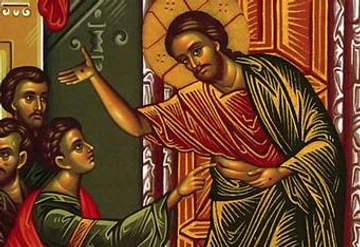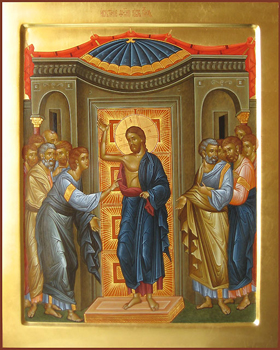For Sunday April 19, 2020
Lectionary Readings (Revised Common Lectionary, Year A)
Acts 2:14a, 22-32
Psalm 16
1 Peter 1:3-9
John 20:19-31
Lent to Eastertide. Death to life. Sorrow to joy. Is it just me, or does the transition feel harder this year? Harder to grasp? Harder to celebrate? Yes, I believe the tomb is empty. Christ is risen, death has been defeated, our sins are forgiven, and love wins. I believe all of this.
And yet.
At the time of this writing, the number of Covid-19 cases around the world has topped 1.7 million, well over 100,000 victims are dead, and the numbers of people suffering physically, psychologically, and/or financially as a result of the pandemic are too high to count. Even as I type these words, I’m struggling to wrap my mind around what they signify. Who can process a tragedy of this magnitude? How should we begin?
More to the point, how should we live into the resurrection at a time when death appears to be in charge? Where and how should the cornerstone reality of our faith apply in this moment? Is it still possible to hold the resurrection close? To view it as more than a theological abstraction?
Thankfully, these questions predate Covid-19 by centuries; we’re hardly the first people to ask them. In fact, the first Sunday after Easter has always been a point in the liturgical year when we take a good, hard look at God’s post-resurrection world, and think, “Now what?” Or (if we’re really honest): “So what?"
Our Gospel story for this week —the story of the disciple Thomas encountering the open wounds of the risen Jesus — is one of the few in the three-year cycle of the Revised Common Lectionary that never changes. A mere seven days after we shout, “Alleluia!” and sing, “Christ the Lord is Risen Today!” we’re invited to struggle alongside “Doubting Thomas." We’re invited to say the "heretical" thing we feel deep inside: “Unless I see him for myself, I won’t believe.” We’re invited to feel wary, skeptical, and (dare we admit it?) envious. Envious of those who find faith easier to sustain than we do. Envious of those who have experienced Jesus more dramatically than we have. Envious of those who, for whatever reason, don’t feel a deep cognitive dissonance between the truth of the resurrection, and the ongoing reality of death in the world.
| |
There’s a great deal to love about Thomas’s encounter with Jesus, but what I love most is that Jesus appears to his skeptical disciple in a body that is scarred and wounded. A body that openly bears its traumatic history. A body that refuses to hide its suffering, its sorrow, its brokenness. What Jesus sports are not old wounds. They are wounds so raw that the doubting disciple places his fingers inside of them. Perhaps Jesus winces when Thomas touches him, but to me, the wincing signals real life, lived at a level we can comprehend. It signals real engagement. Real presence. Real pain. It speaks the very words I hunger to hear: "I am with you. I am with you where it hurts. I don't float thousands of sanitized feet above reality. Even after death, I dwell in the hot, searing heart of things. Exactly where you dwell."
In my experience, Christians are expected to put a lot of stock in completed victories. We value the race won, the mountain scaled, the enemy defeated, the obstacle overcome. We welcome stories of failure to an extent, but only when those stories are shared in retrospect, long after the sordid worst is over. Sin that has surrendered to holiness? That's a Christian story. But sin that clings? Challenges that won't ease up? A wound — physical, psychological, or relational — that remains? We squirm. We turn our eyes away. We worry.
But Jesus’s wounded body reminds me that some hurts are for keeps. Some markers of pain, loss, trauma, and horror leave traces that no amount of piety will take away. Some wounds remain, even after resurrection — and that's okay. It's okay to celebrate Jesus's rising — and grieve our catastrophic losses at the same time. It's okay to hear other people's uplifting faith stories and say, "I'm happy for you, but my heart is still broken." It's okay to ache for more of Jesus, and to hold our ache in tension with the joys of Easter.
This year — more than ever — I cherish the wounds in Jesus’s post-resurrection life. On this first Sunday after Easter, even though we are a resurrection people, we are still hurting. The world is still wounded. Regardless of where on the planet we live, we are still anticipating grief on a scale most of us have never experienced before. This year especially, Jesus’s scarred body speaks with great power, tenderness, mercy, and truth. Allow them to speak to you.
 |
If you’re finding the joy of Easter difficult to access right now, rest in the fact that Jesus never sheds the marks of his pain — not even when he bursts from the tomb. Contemplate the wonderful truth that ours is a religion of paradoxes: we Christians live by dying, receive by giving, rule by serving. Our job is not to collapse these paradoxes, but to honor their complexities, and live fruitfully within them. Jesus' resurrected body — his victorious body — still retains its scars.
The other aspect of the post-resurrection Gospel story I cherish is Thomas’s own faith journey. I know that he often gets a bad rap in the Church. His reluctance to accept the testimony of his fellow disciples, his insistence on physical proof, his late arrival to the joyous belief of his peers — these are often described as spiritual flaws. As signs of stubbornness, or of a weak faith.
But I disagree — I’m Thomas’s loyal fan. I’m grateful for his honest skepticism, his brave doubt, his slow, methodical conversion. He reminds me that the resurrection story is hard. Hard to accept, hard to internalize, and hard to apply to our lives — especially when our lives are marked by pain, loss, uncertainty, and death. The Church’s glorious Easter hymns notwithstanding, the week after Easter has always been murky, messy, and complicated. I’m not the first human being to struggle with it, and I won’t be the last. In fact, struggle seems to be intrinsic to the disciples’ post-Easter encounters with Jesus.
When I look at Thomas, I see a man who yearns for a living encounter with God. A man who can’t settle for someone else’s experience of resurrection, but sticks around in the hope of having his own. A man who dares to confess uncertainty in the midst of those who are certain. A man who recognizes his Lord in woundedness, not glory.
 |
According to John’s Gospel, Thomas has to wait in suspense for a whole week after his friends first tell him they’ve seen Jesus. What, I wonder, does that week feel like for the disciple who misses Jesus the first time around? Does he pity his fellow disciples for what he fears are their delusions? Or does he fear (as I so often do) that he’s missed the memo, missed the boat, missed the glory? Does he wonder if he’s destined only ever to know God secondhand? Does he ask why Jesus won't come sooner for him?
What strikes me most about Thomas’s story is not that he doubts, but that he does so publicly, without shame or guilt. How different our churches would be if we embraced doubters as generously as Jesus and his other disciples embrace Thomas. The disciples hold space for the cynic, the holdout. They allow him to voice his skepticism, and name his yearning to see the risen Jesus with his own eyes. Though they freely share their testimonies with him, they simultaneously give him time and space to encounter Jesus on his own. Meanwhile, Jesus meets Thomas right where he is, freely offering the disciple the testimony of his own wounds, his own pain.
Wounds and doubts. Doubts and wounds. Welcome to life the week after Easter Sunday. Welcome to life in the shadow of the empty tomb. If this sounds anticlimactic, then consider this: When Thomas’s doubts meet Jesus’s wounds, new life erupts, faith blossoms, and the doubting disciple becomes an apostle of the good news. Resurrection happens all over again.
Jesus honors the desire to see more, experience more, encounter more. He blesses those who struggle to believe, but stick around, anyway. He leans towards those who yearn for more of him. Jesus leads with brokenness so that we might follow him into glory. During this Week After, during these hard times, may we find our solace, hope, and courage in the wounded, risen Christ.
Debie Thomas: debie.thomas1@gmail.com
Image credits: (1) The Hilltop Shepherd's Watch; (2) Marriage Encounter Movement of California; and (3) A Reader's Guide to Orthodox Icons.





